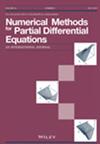Parameter robust higher‐order finite difference method for convection‐diffusion problem with time delay
IF 1.7
3区 数学
Q1 MATHEMATICS, APPLIED
引用次数: 2
Abstract
This paper deals with the study of a higher‐order numerical approximation for a class of singularly perturbed convection‐diffusion problems with time delay. The method combines a higher‐Order Difference with an Identity Expansion (HODIE) scheme over a piece‐wise uniform mesh in the spatial direction and the backward Euler method on a uniform mesh for discretization in the temporal direction. A priori bounds for the continuous solution and its derivatives are derived by splitting the solution into regular and singular components. These bounds are useful in the error analysis of the proposed scheme. The present scheme converges ε$$ \varepsilon $$ ‐uniformly with the order of convergence one in time and almost second‐order in space direction. Further, to increase the rate of convergence in the time variable, we implemented the Richardson extrapolation technique. Thus, finally, the resultant scheme with Richardson extrapolation in time becomes almost second‐order ε$$ \varepsilon $$ ‐uniformly convergent in both the space and time variable. The detailed stability and convergence analysis have been done using the derived a priori estimates. We consider three test problems to validate the predicted theory and show that numerical results are in good agreement with our theoretical findings.时滞对流扩散问题的参数鲁棒高阶有限差分方法
本文研究了一类具有时滞的奇摄动对流扩散问题的高阶数值逼近。该方法在空间方向上的逐片均匀网格上结合了高阶差分和恒等式展开(HODIE)方案,在时间方向上结合了均匀网格上的后向欧拉方法进行离散化。通过将连续解分解为正则分量和奇异分量,导出了连续解及其导数的先验界。这些边界在所提出的方案的误差分析中是有用的。本方案在时间上以一阶收敛,在空间方向上几乎以二阶收敛,使ε$$\varepsilon$$一致收敛。此外,为了提高时间变量的收敛速度,我们实现了Richardson外推技术。因此,最后,在时间上进行Richardson外推的结果方案在空间和时间变量上几乎是二阶ε$$\varepsilon$$一致收敛的。使用推导的先验估计进行了详细的稳定性和收敛性分析。我们考虑了三个测试问题来验证预测理论,并表明数值结果与我们的理论结果非常一致。
本文章由计算机程序翻译,如有差异,请以英文原文为准。
求助全文
约1分钟内获得全文
求助全文
来源期刊
CiteScore
7.20
自引率
2.60%
发文量
81
审稿时长
9 months
期刊介绍:
An international journal that aims to cover research into the development and analysis of new methods for the numerical solution of partial differential equations, it is intended that it be readily readable by and directed to a broad spectrum of researchers into numerical methods for partial differential equations throughout science and engineering. The numerical methods and techniques themselves are emphasized rather than the specific applications. The Journal seeks to be interdisciplinary, while retaining the common thread of applied numerical analysis.

 求助内容:
求助内容: 应助结果提醒方式:
应助结果提醒方式:


